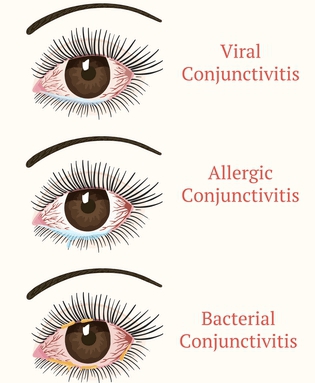Eye flu, or conjunctivitis, refers to the inflammation of the conjunctiva—the thin, transparent tissue that covers the white part of the eye and the inner side of the eyelids. This condition can be caused by various factors, including viruses, bacteria, allergens, or irritants. Eye flu is highly contagious, spreading rapidly, particularly in crowded environments.
What is Eye Flu?

Types of Conjunctivitis

Viral Conjunctivitis
Often associated with upper respiratory infections like the common cold, this type is caused by viruses such as adenovirus. It typically begins in one eye and quickly spreads to the other, causing redness, watering, and a gritty feeling in the eyes.
Bacterial Conjunctivitis
Bacterial conjunctivitis is caused by bacteria like Staphylococcus aureus and Streptococcus pneumoniae. This type is characterized by a thick, yellow or green discharge and can affect one or both eyes. It may also cause the eyelids to stick together, especially upon waking up.
Allergic Conjunctivitis
Allergic conjunctivitis is triggered by allergens such as pollen, dust mites, or pet dander. It causes intense itching, redness, and watery discharge. Unlike viral and bacterial conjunctivitis, allergic conjunctivitis is not contagious.
Irritant Conjunctivitis
Irritant conjunctivitis occurs when the eyes are exposed to irritants like chlorine in swimming pools, smoke, or chemical fumes. It leads to redness, discomfort, and watery eyes but is not contagious.
Symptoms of Eye Flu

The symptoms of eye flu can vary depending on the cause, but they generally include:
- Redness in one or both eyes
- Itching or burning sensation
- Watery or thick discharge
- Swelling of the eyelids
- Sensitivity to light
- Feeling like sand is in the eye
Prevention of Eye Flu

Understanding how eye flu spreads is crucial for preventing its transmission. Since the condition is highly contagious, especially in crowded settings, adhering to preventive measures is essential. Here are some effective strategies to prevent the spread of eye flu:
Maintain Good Hygiene
Wash your hands frequently with soap and water, especially after touching your face or eyes.
Avoid Touching Your Eyes
Refrain from touching or rubbing your eyes to minimize the risk of infection.
Use Personal Items
Avoid sharing personal items like towels, pillows, eye makeup, or contact lenses.
Disinfect Common Surfaces
Regularly clean surfaces that are frequently touched, such as doorknobs, light switches, and remote controls.
Wear Protective Eyewear
When going outside, especially in dusty or allergen-rich environments, wear sunglasses to protect your eyes.
Eye Flu Treatment Options

Home Remedies
If you suspect you have eye flu, it is important to consult a doctor for an accurate diagnosis and appropriate treatment. However, you can also try the following home remedies to alleviate symptoms:
Warm Compress
For bacterial conjunctivitis, warm compresses can help soothe the eyes and loosen any crusty discharge.
Avoid Irritants
Stay away from smoke, dust, and other irritants that may aggravate your symptoms.
Medical Treatments
Depending on the type and severity of the infection, your doctor may prescribe medications such as:
- Antibiotic Eye Drops: For bacterial conjunctivitis, antibiotic eye drops like Ciplox (ciprofloxacin) or moxifloxacin can help clear the infection.
- Antiviral Medications: In cases of severe viral conjunctivitis, antiviral medications may be prescribed.
- Antihistamines: For allergic conjunctivitis, antihistamine eye drops can relieve itching and redness.
- Over-the-Counter Eye Drops: Artificial tears or lubricating eye drops can alleviate dryness and irritation. However, it is essential to consult your doctor before using any medication.
Conclusion
Eye flu, or conjunctivitis, is a common yet highly contagious condition that can cause significant discomfort. Understanding its symptoms, causes, and treatment options is essential for effective management and prevention. By maintaining good hygiene, avoiding direct contact with infected individuals, and seeking prompt medical attention, you can reduce the risk of contracting or spreading eye flu. Stay informed, stay protected, and ensure that your eyes remain healthy and safe.